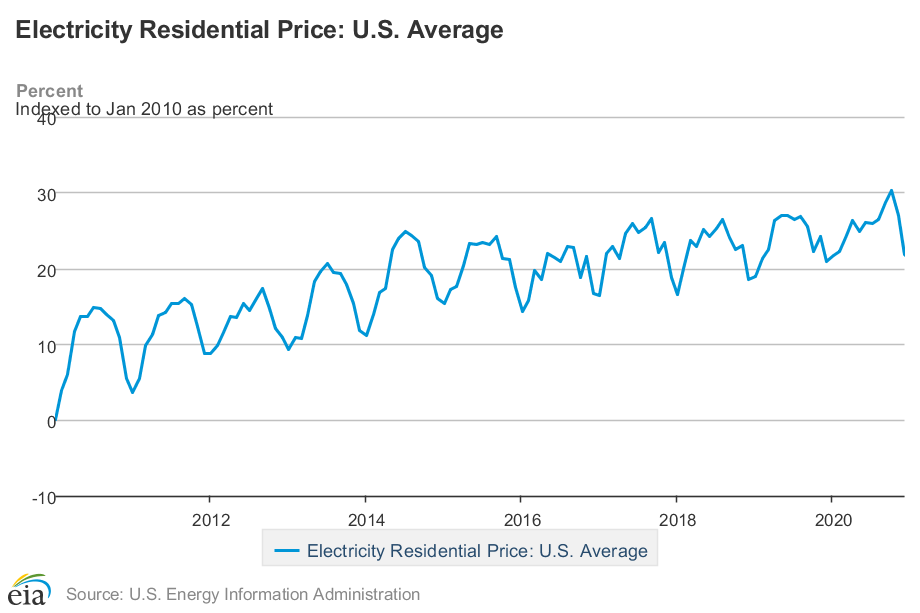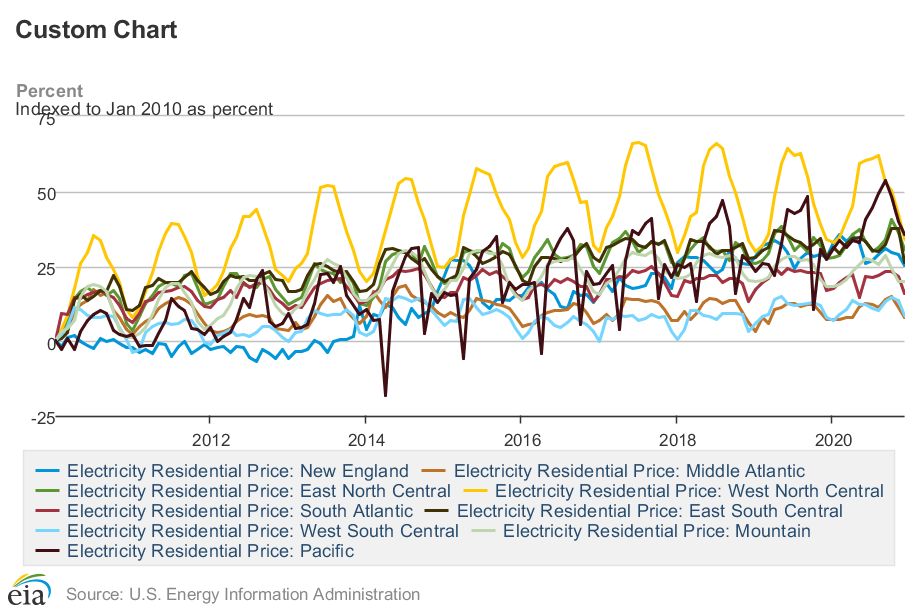If you’re considering whether going solar is a worthwhile financial move for your home, there are essentially two factors that you should look at: 1) the costs associated with solar power, and 2) the rates you pay for electricity from your utility. Going solar makes economic sense when solar electricity costs less than grid electricity.
Key takeaways
- Retail residential electricity rates (the amount you pay per kilowatt-hour, or ¢/kWh) have risen across the nation about 14% over the last 10 years (i.e., between 2010 and 2020).
- This trend is unlikely to be disrupted in the future: natural gas prices are only likely to increase, and as they do electricity rates will rise.
- Electricity prices fluctuate annually, seasonally and monthly. Installing a solar energy system can help you insulate yourself against these fluctuations.
- Your choice to purchase or lease your a solar system will impact your total savings.
- If you’re thinking about going solar, make sure you know all of your options before you make a decision. EnergySage can help you do this: Start by getting an instant estimate and then compare installers and financing choices on our Solar Marketplace.
What’s in this article?
- What to know about solar energy costs
- Have electricity prices changed in the past 10 years?
- Could electricity rates fall in the future?
- Electricity price fluctuations over time and by location
- Things to know if you’re thinking about going solar
What you should know about solar energy: costs are going down
As for solar, it is clear that costs are coming down. Rooftop solar panels are now more affordable and accessible than ever. This is why more and more households are having solar energy systems installed: going solar is a great way to reduce your power bills.
But what about the future cost of grid electricity? If electricity rates are going up, then of course going solar makes sense. As you’re probably aware, however, utility electricity rates fluctuate seasonally and annually. “What if utility electricity rates go down instead of up?” you might be asking yourself. Would it still be worth it for you to go solar? This article seeks to address this question and put to rest any idea that grid electricity rates could be going down.
How have electricity prices changed in the past 10 years?
Utility residential electricity prices have risen steadily in the last decade. According to the Energy Information Administration, residential electricity rates have increased nationally by around 14% in the last 10 years (an increase of a little under 0.2¢/kWh per year).

This graph, from the Energy Information Administration (EIA), shows the increase in average residential electricity prices as a percentage between 2010 and 2020 (the most recent year for which annual data is available). During this period, US residential electricity prices rose by 14%.
This may not sound like much, but these numbers add up over time: if your home uses about 500kWh of electricity per month, by the end of this 10-year period, you will have paid significantly more for your electricity than if rates had stayed at their 2010 levels.
Could electricity prices fall in the future? It’s unlikely
“The past is no predictor of the future”, you might argue. And it’s true that just because electricity prices have been going up does not mean that they will continue to do so. However, there are a number of very good reasons why it is unlikely that residential electricity rates will fall in the future.
- While natural gas prices fell in the aughts and beginning of the 2010s thanks to the ‘fracking’ boom, prices have increased over the last couple of years, especially during winter months, leading to seasonal spikes in electricity prices. This trend may continue as America’s natural gas supply is exposed to international markets – Europe and Japan, for example, currently pay significantly more for natural gas than the US.
- Extreme temperatures can drive up the demand for electricity, as more energy is needed for heating and cooling, among other operations. As climate change continues to progress and extreme weather becomes more widespread, this higher demand will likely drive electricity prices higher.
- The Energy Information Agency also predicts that electricity price is going to increase, both in the short-term as well as the long-term (out to 2040).
Electricity price fluctuations over time and by location
On average, electricity prices in the US certainly seem to be on an upwards trajectory. But this is only part of the story: while the first graph in this article demonstrates how prices fluctuate over time nationally, it’s important to also understand how prices differ depending on where you live.
10-year changes by region
The graph below shows electricity pricing trends in different parts of the country over the past decade. Although an overarching upwards trend is clear, the story is not the same in every region. For example, electricity prices in the East North Central region (Indiana, Illinois, Wisconsin, Ohio and Michigan) and West North Central region (Iowa, Kansas, Minnesota, Missouri, Nebraska and the Dakotas), rose steadily. Meanwhile, electricity prices in the West South Central states (Arkansas, Louisiana, Oklahoma and Texas) have remained comparatively steady.

10-year changes by state
The graph below illustrates electricity price trends in a handful of states. You can see that prices have risen significantly in most of these states over the 10-year period between 2011 and 2021. Some have risen more than others, however – average prices in New Jersey, for instance, have only risen slightly, while they’ve increased dramatically in California, Massachusetts, and Washington, to name a few states.

5-year changes by state
Interestingly, if we look at prices over only the last five years (2016 to 2021), we see that rates have continued to rise in most states, with the exception of a slight drop in Maryland and price stagnation in Pennsylvania, adding some variability of electricity prices in the short-term despite the clear upward trend in the longer-term.

How have electricity prices changed in Massachusetts?
Taking Massachusetts as an example (in the chart below), you can see that the gradual upwards pricing trend has not been steady. Instead, prices have spiked seasonally in recent years – and sometimes significantly so, as was the case during the beginning of 2015. But over the 10-year period, residential electricity prices have increased here in EnergySage’s home state by about 50%.

If you want to understand how much electricity you use in your home each day, check out our section on energy management systems – and consumption monitors in particular – to learn more about how to get a better handle on your electricity usage.
What does all of this mean if you are thinking about going solar?
There are some important implications in all of this if you are thinking about going solar:
Solar gives you more control over your electricity bill
Utility electricity rates go up and down throughout the year, but have a long-term tendency to rise. These fluctuations, which are the result of fuel costs and a number of other factors, are completely outside of your control. Going solar gives you some control over how much you pay for electricity by protecting you against rising electricity prices.
Solar is more predicable than utility electricity
Having a solar energy system on your roof is one effective way to reduce your power bills because the electricity generated by your solar panels is not subject to the same variations that utility electricity is. Therefore, if you go solar, your electricity costs will always be more predictable than if you stick with grid electricity. In the long term, they will almost certainly be lower with solar than with grid electricity.
What should you expect from your electricity bills after you’ve gone solar?
The answer to this question depends on how you finance your system: you can either purchase or lease your solar system.
Purchased system
If you purchase your solar system (either with cash or a solar loan), your electricity bill will be greatly reduced or completely eliminated soon after the system is connected to the grid. These monthly savings will eventually ‘pay off’ the original cost of the system. The typical payback period for a solar system in the US is in the range of 5-12 years. Fluctuations in your utility’s electricity rates will not affect this by much, and once the system is paid off, the electricity it produces is basically ‘free’. You will have no or only very small electricity bills for the remainder of your solar system’s life (25-30 years total).
Leased system
If you choose to install your system through a solar lease or power purchase agreement (PPA), you will most likely start saving money immediately. However, when you sign up with these programs, the amount you pay for solar will be fixed for the duration of your contract (usually 20 years). You will either lock in your solar payments a flat rate (e.g. 10¢/kWh, or a set price per month) for the entire duration of the contract, or your solar rate will be subject to an ‘escalator’, which causes the rate you pay for solar to increase by a set percentage (e.g. 2.5%) every year. This means that if your electric utility’s rates go down instead of up, you may temporarily find yourself paying more for solar than you would have if you had stuck with purchasing your power from your utility. This is particularly likely if the rate the solar company promises you is only slightly lower than your current utility rate.
The graphs below (which are examples only) illustrate these points:
Savings over 20 years
Below is an example of how solar lease/PPA rates can be lower than utility electricity over a 20-year period. This graph compares the rates that you might pay for utility electricity against rates you would pay for solar electricity (from a system on your roof). Note that in years 1-4 the utility electricity price is sometimes lower than the solar electricity price. Note that if you owned your solar energy system, your power bill would be $0 (or close to $0) for the duration of the 20 years, so we have not included this option in the graph.
Total electricity costs over 20 years
The graph below illustrates the total amount you would pay for electricity over 20 years under the different examples in the preceding graph.
Start your solar journey today with EnergySage
The best way to protect yourself from rising electricity costs is by going solar – and the best way to go solar is through EnergySage! When you sign up for a free account on the EnergySage Marketplace, you’ll receive custom quotes from local installers. By comparing these quotes side-by-side, you’ll be able to find a system that meets your needs at the right price, all from the comfort of your own home.

Home Energy Upgrades You May Like



Note: This post contains affiliate links. We only link to products that we think are great.








